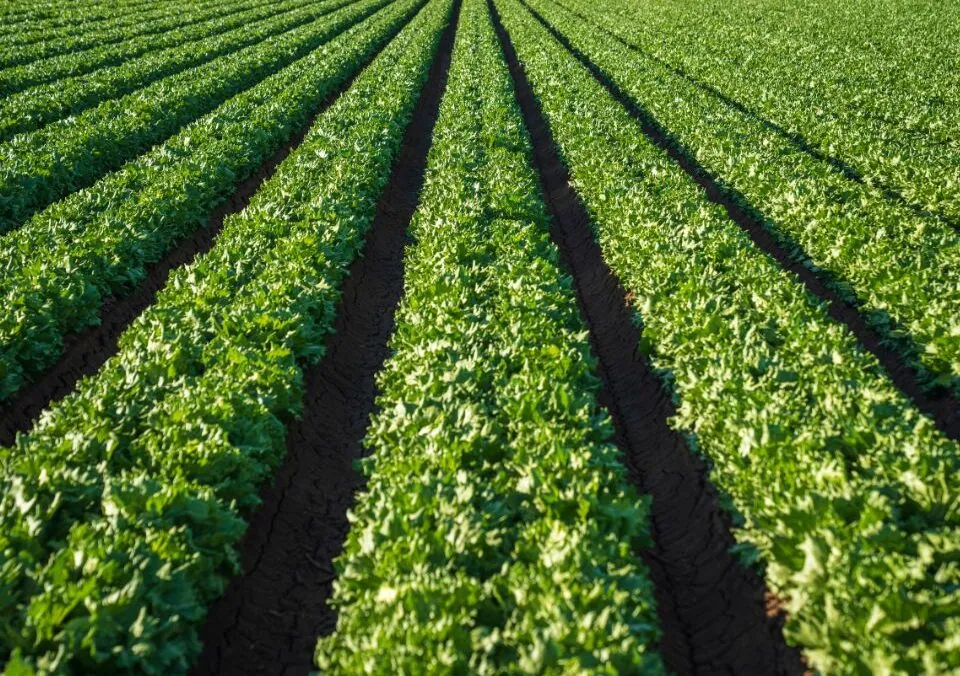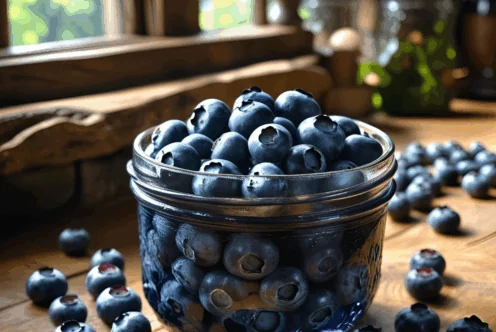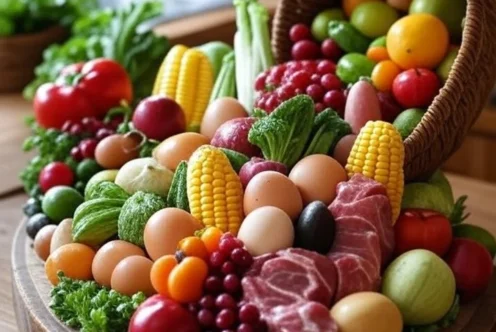Blog
Enjoy Winter Lettuce Thanks to Yuma, Arizona!

Hanging in my closet is a t-shirt that reads, “Ever had a salad in December? You’re welcome – Yuma, Arizona” Whenever I wear it, I sometimes get asked what that’s even supposed to mean, or what salads have to doHanging in my closet is a t-shirt that reads, “Ever had a salad in December? You’re welcome – Yuma, Arizona”. I often get curious looks. Strangers are quick to ask what that’s all about. What’s the connection between Yuma, Arizona, and salads? It’s the perfect conversation starter to have the chance to educate consumers about where their food comes from because lettuce really does have a lot to do with Yuma!
For those unfamiliar, Yuma is a small city located in the southwestern corner of Arizona, but what it lacks in size, it makes up for in agricultural significance. During the winter months, when most parts of the country are shivering in the cold, Yuma is experiencing something entirely different: a thriving lettuce-growing season that feeds millions. Let’s dive deeper into why Yuma is integral to the winter lettuce supply and explore the fascinating agricultural practices that make it possible.
The Winter Lettuce Capital of the World
Yuma is often referred to as the “Winter Lettuce Capital of the World.” This title isn’t just a catchy phrase; it’s backed by impressive statistics and agricultural practices that make Yuma unique. The city’s location and climate enable local farmers to cultivate a vast amount of lettuce when other regions struggle with frost and freezing temperatures.
Scientists and agricultural experts have long praised Arizona for its warmer winters. This climate is crucial for the growth of lettuce, which thrives in cool but not freezing temperatures. On average, Yuma enjoys more than 300 sunny days a year, creating an ideal environment for green leafy vegetables to flourish year-round. 1.
A Booming Industry
The lettuce industry in Yuma is nothing short of monumental. Reports show that Yuma ships about 1,000 to 1,200 truckloads of lettuce daily to various locations throughout the United States and Canada. This accounts for a significant portion of the winter lettuce consumed across North America. According to the California Leafy Greens Marketing Agreement, Yuma produces roughly 90% of the lettuce consumed in the U.S. during the winter months.
But what types of lettuce are produced? In Yuma, farmers grow different varieties, including head lettuce, romaine, and leaf lettuce, helping consumers across the nation enjoy crisp, fresh salads throughout the colder season.
The Scale of Production
In terms of land use, Yuma’s agricultural footprint is impressive. Approximately 45,000-55,000 acres are dedicated to lettuce cultivation annually. This vast expanse of farmland is meticulously managed to produce high-quality greens. Many families and businesses have depended on this industry for generations, forming an agricultural community that is both culturally rich and economically significant.
In addition to lettuce, Arizona’s unique climate allows for the production of various crops, including broccoli, cauliflower, and spinach. The range of produce contributes to Arizona’s diverse agriculture scene and provides a slew of fresh options to consumers throughout the year.
Agricultural Practices and Sustainability
Farmers in Yuma utilize various agricultural techniques aiming for sustainability and high yield. Many practices focus on water conservation, as the area does not receive substantial rainfall. Advanced irrigation systems, such as drip irrigation, are employed to ensure that crops receive adequate water without excessive waste. Research from the University of Arizona emphasizes the importance of sustainable practices that preserve the region’s natural resources while meeting the growing food demands.
Additionally, Yuma’s agricultural community actively participates in research and educational programs to enhance crop production techniques. This effort not only benefits farmers but also provides consumers with high-quality and safe food. Organizations like Arizona Farm Bureau contribute resources and information to support farmers in their endeavors.
The Role of Technology
Modern technology plays a pivotal role in how Yuma farmers produce lettuce. Innovations such as precision agriculture, data analytics, and automation allow growers to optimize their yields and maintain consistent quality. By employing satellite imagery and soil sensors, farmers can assess crop conditions and apply fertilizers and water more effectively.
For instance, using drones has become increasingly popular in agricultural management, allowing for thorough monitoring of fields without the need for extensive manpower. Technology not only increases efficiency but also helps in identifying issues like plant disease or pest infestations early on, ensuring that all possible measures are taken to protect crops.
Health Benefits of Lettuce
It’s not just about production; the health benefits of consuming lettuce cannot be overlooked. Leafy greens like lettuce are nutrient-rich, providing essential vitamins and minerals. They are low in calories and high in dietary fiber, making them an excellent addition to a balanced diet. Lettuce is also packed with antioxidants that can contribute to overall health and wellness.
In the U.S., many households consume salads regularly, especially during the holiday season, when fresh greens complement rich and hearty meals. An article from the Centers for Disease Control and Prevention (CDC) emphasizes the importance of incorporating fruits and vegetables into diets. Salads can be dressed up with various toppings, making them wholesome, delicious, and versatile.
Connecting with Consumers
Educating consumers about where their food comes from is vital, especially in an age where many people are disconnected from agricultural practices. The Yuma Agricultural Coalition works diligently to share information with the public and encourage a farm-to-fork mentality. Their efforts include educational farm tours, workshops, and community events designed to engage local residents and visitors alike. 2
When you enjoy a winter salad, think about the journey it has taken. From the fields of Yuma to your dinner plate, many farmers have worked tirelessly to ensure its freshness and quality.
Recipes to Enjoy Arizona-Grown Lettuce
If you want to incorporate Yuma’s fresh greens into your meals, consider trying out recipes that highlight Arizona-grown lettuce. Here are a few delicious ideas:

- Classic Caesar Salad: Toss romaine lettuce with homemade Caesar dressing, croutons, and freshly grated Parmesan for a classic dish that never goes out of style.
- Mediterranean Lettuce Wraps: Use leaf lettuce leaves to wrap grilled chicken, diced tomatoes, cucumbers, olives, and feta cheese. Drizzle with olive oil and lemon juice for a healthy and hearty meal.
- Lettuce and Avocado Salad: Combine mixed greens, sliced avocados, cherry tomatoes, and red onion. Dress with balsamic vinaigrette for a simple yet satisfying salad.
- Asian-Inspired Salad: Mix romaine lettuce with shredded carrots, bell peppers, and green onions. Top with a ginger sesame dressing and sprinkle with sesame seeds for an invigorating dish.
- Winter Panzanella: Combine cubed day-old bread, chopped lettuce, roasted butternut squash, and cranberries. Drizzle with a cider dressing for a festive twist on this classic Italian dish.
You can find more recipe ideas featuring Arizona-grown produce on the Fill Your Plate blog.
The Economic Impact of Lettuce Production
Yuma’s lettuce production is not just significant for the consumer’s plate; it also has a massive economic impact on the region. The agricultural sector provides thousands of jobs, supporting local families and businesses. It also boosts related industries, such as transportation and food packaging.
Moreover, Yuma’s reputable agricultural status attracts tourism and educational ventures. For agricultural enthusiasts and culinary professionals, opportunities abound in the region to learn about farming practices and how to prepare fresh, local produce.
Conclusion
So, the next time you take a bite of a winter salad, remember the hard work that goes into each leaf of lettuce and the role that Yuma, Arizona, plays in providing this nutritious staple. The farmers in Yuma are the unsung heroes behind the fresh greens that grace our tables, and their dedication to sustainable practices ensures that we continue to enjoy healthy food year-round. Let’s appreciate the connection we have with our food, the farmers that grow it, and the unique agricultural practices that make regions like Yuma so vital to our everyday meals.
Whether you’re gardening, supporting local farmers, or simply enjoying a salad, remember the journey from Yuma to your plate! It’s a delicious connection worth celebrating.
By Heide Kennedy, Arizona Farm Bureau Communications Intern


















